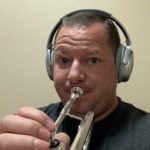WindWorks Trumpet Academy › Forums › WindWorks › Dry lips vs wet
- This topic has 3 replies, 3 voices, and was last updated 2 years, 11 months ago by
paulholly.
-
AuthorPosts
-
-
25 August 2021 at 5:46 am #95519
paulholly
ParticipantWonder if anyone has experience in wet vs dry lips and benefits/problems?
I’ve always been a wet lips player, but recently had a lesson with an excellent jazz player (with an amazing range) who has always played dry.
Possibly subconsciously whilst I was working on 2 octave flexibility exercises (tongued and slurred) I let my lips dry and discovered that when placing my (ahhh – oooh) lips for a low C, slurring up 2 octaves became much easier with passive breath. The high C really sounded strong with no pressure or effort. I suspect that retaining the open aperture became easier as it required less inward aperture corner strength as the embouchure was “stuck” in the right place.
I’m not sure about trying to convert to dry, but wonder whether this demonstrates effectively, the need to strengthen the inward (horizontal) aperture muscles.
P.S. I have discovered a “great” method of determining when I start to blow actively: I cracked a rib about 4 weeks ago and whenever I blow hard my chest aches. Bonus though, is its a great passive vs. active breath meter.
-
25 August 2021 at 10:15 am #95554
 Rob ThomsonParticipant
Rob ThomsonParticipantYou’re sending warm, moist air through the aperture, anyway. It’s like Houston in April. If they start dry, they don’t stay that way. I don’t think it really matters.
This discussion reminds me of Bryan Duncan’s very funky version of the Andrae Crouch classic, “It’s Gonna Rain.”
-
25 August 2021 at 10:25 am #95558
johnelwood
ParticipantI’ve always played wet, FWIW. As may be evident from some of my other posts, I “geeked out” pretty hard a couple years ago on trumpet embouchures and read, in addition to WindWorks / Greg’s material, some material by others.
In his book “The Art of Brass Playing”, Phillip Farkas devotes an entire chapter (albeit, only a couple of pages long) on “Moist vs. Dry Lips”. Farkas estimated that approximately 75% of players preferred wet lips, as did he, but acknowledged the fact that several fine players preferred dry lips. In his book, he outlines the pros vs cons of both.
You might want to check it out.
Some of his points Against dry lips are:
1. The mouthpiece tends to stick to the first spot it’s placed on and it’s difficult to maneuver to a slightly more ideal spot based on how things feel / sound.
2. “The very act of bracing the dry lips against the mouthpiece for aid in obtaining high notes acts as a crutch in preventing the most complete development of the lips. Should the lips inadverdently become moist, they will slip out of the mouthpiece upom attempting high notes, not having the inherent strength to obtain them without that crutch–that necessity to adhere themselves to the mouthpiece rim.”
He goes on further to explain how he believes that using wet lips allows a player to fully develop his embouchure such that he’s using the correct muscles to keep the lips in place, rather than relying on dry lips to do so.
I found #2 particularly interesting. Having not played dry, it’s kind of hard for me to relate to this. However, I think I more or less “get it”.
I am wondering if the player you mention you took lessons from was Kurt Thompson (Trumpet Sizzle)? I watched a couple of his videos on YouTube and recall he mentioned that he advocates playing dry.
Hope this is helpful, FWIW.
-
28 August 2021 at 7:17 pm #96084
paulholly
ParticipantThanks John, I haven’t read the Phillip Farkas book, but the points you raise are exactly what concerned me with converting to a dry placement.
I’m aware of Kurt Thompson’s youtube output but have never taken up the offer of lessons with him. And just to be clear the player wasn’t advocating I change but as he’d only ever played with a dry placement – and does a lot of Dizzy-like bebop playing – it made me wonder whether there were benefits. However right now I need I’m revising Greg’s approach to ensure i’ve understood 100%.
Whilst on Kurt – I have used his “no pressure” lip slur idea and also the exercise of placing to either sides of the mouth. The latter does work-out the muscles, and may have some benefit, if not overused.
-
-
AuthorPosts
- You must be logged in to reply to this topic.
Recent topics
-
Question of Curiosity – To Teeth or Not To Teeth
by
clawsonk123
1 month, 2 weeks ago -
1.O / 2.0 routine
by
jice.gif
2 months, 3 weeks ago -
Abdominal surgery and time off the trumpet
by
DQ
9 months, 3 weeks ago -
Allegro or Presto Practice Routine
by
djm297
10 months, 2 weeks ago -
Tongue lock – Throat lock
by
Ivo Carrabs
11 months, 1 week ago
